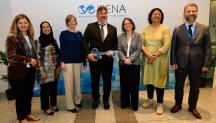

To Make the Energy Transformation a Success, Be Unafraid to Fail
Newsletter
During a Ministerial Roundtable at IRENA’s 9th Assembly in Abu Dhabi, government officials from around the world gathered to discuss the ongoing power sector transformation, and examine new, disruptive innovations emerging that are changing the ways in which energy systems are configured and operate, and how they are beginning to change roles for many actors.
Driving the energy transformation is rapid changes with regards to the power sector. The price of PV modules dropped by more than 80% and the cost of electricity from solar PV fell by almost 75% in the years between 2009 and 2018, while the price of wind turbines fell by about 50% over the same period. Onshore wind electricity costs dropped by almost 25% between 2010 and 2018.
Renewable power generation accounted for an estimated quarter of total global power generation in 2017, yet the energy transition needs a further acceleration of this growth. According to IRENA’s analysis, a decarbonization of the power sector, in line with the climate objectives outlined in the Paris Agreement, would require a share of renewable energy in total electricity generation of 85% by 2050. Furthermore, the share of electricity consumed in the total energy demand of end-use sectors – industry, transport and buildings – need to double from around 20% in 2015 to 40% in 2050.
Kicking-off, the session, IRENA Director-General Adnan Z. Amin noted that innovation is the engine powering the global energy transformation, and that digitalisation and electrification and having a profound impact on global energy systems. Director of the IRENA Innovation & Technology Centre Dolf Gielen pointed out the scale of changes that the transformation will bring, with solar PV rising from 3% of global energy mix to a quarter in 2050, and onshore wind rising from 7% to more than one-third. These will place significant demands on energy infrastructure, which will have to adapt to integrate high shares of variable renewables in the mix. Yet innovation efforts are now broadening to include the development and deployment of solutions that create the flexibility needed to integrate high share of variable renewable energy and increasingly to electrify the end-use sectors of transport, buildings and industry, and sector coupling are presenting reasons to be optimistic. As Mr. Gielen pointed out, “combined innovations yield effective solutions.”
But this requires new business practices as well. ENEL CEO Francisco Starace raised this in his opening remarks, “Things are getting lighter, cheaper, and easier to build. This trend is not going to stop. But fragmentation and speed of change are also causing business innovation, and there is also an increasing interplay with other sectors, that were previously not important in the energy sector.” Importantly, Starace noted, “Players that will be successful in the new energy paradigm must be unafraid to fail. This requires a culture of optionality that we have not seen yet.”
The diversity of innovations emerging and the speed at which they are being adopted will have far reaching implication for the configuration and operation of energy systems and the roles of all actors involved. Utilities are moving from selling electricity to providing additional services to customers. Consumers, meanwhile, are becoming electricity producers. New entrants such as ICT and car-manufacturing companies can also provide services to power systems.
Yet different contexts may call for different innovative responses to challenges of energy transformation. Siemens Chair and CEO CEO Lisa Davis made this clear, “To capture the benefits of the stark shifts in the energy system, both developed and developing countries need to evaluate their options. Sector coupling, technological innovation, and new forms energy and energy storage are going to bring drastic changes.”
50 Hertz CEO Boris Schucht pointed out that it is vital not to overlook the depth of changes needed in the regulatory and legal environment, “We often talk about business innovation and technological innovation in energy transformation, but we should never underestimate the changes needed in terms of the legal and regulatory framework.”
A diverse series of interventions followed, reinforcing the idea that while countries will follow their own path to energy transformation, all can benefit from an exchange of knowledge and experience across sectors and countries, and this is where IRENA plays an important role.
The high-level meeting built on discussions from IRENA Innovation Week, held in September in Bonn, Germany. Across three days 80 expert speakers and over 350 participants from over 70 countries met to showcase examples of innovative solutions from around the world, deepen their mutual understanding of the opportunities and challenges, and explore how to accelerate and broaden the uptake of solutions and benefit many more countries.
During the roundtable delegates also discussed a preview of the upcoming ‘Innovation landscape for a renewable-powered future’ report which, together with its accompanying detailed online resources, will provide decision makers with a clear, easily navigable but comprehensive guide to the diversity of innovations in use or development in many countries across the globe.
Technological, business and regulatory innovation still have a long way to go. We are still in the formative stages of a debate that has been, however, given a significant momentum by the urgent imperatives of climate change and growing energy demand. The platform that IRENA presents support an open-source approach, where all countries identify the best practice, and then make it available to all.




